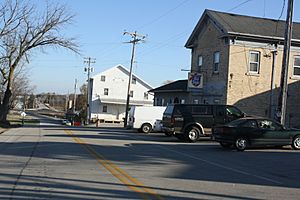Boltonville, Wisconsin facts for kids
Quick facts for kids
Boltonville, Wisconsin
|
|
|---|---|

Looking east at downtown Boltonville
|
|
| Country | |
| State | |
| County | Washington |
| Elevation | 266 m (873 ft) |
| Time zone | UTC-6 (Central (CST)) |
| • Summer (DST) | UTC-5 (CDT) |
| Area code(s) | 262 |
| GNIS feature ID | 1562045 |
Boltonville is a small, quiet community in Wisconsin, United States. It's located in Washington County, right by a stream called Stony Creek. Boltonville is an unincorporated community, which means it's not a separate city or town with its own government, but rather a part of a larger area called Farmington.
History
Early Days
Boltonville was started in 1854 by a person named Harlow Bolton. While many people in the surrounding area of Farmington came from Germany, Boltonville became a special place for people who immigrated from Ireland.
The first settlers in Boltonville used the power of Stony Creek. They built mills that used water power. These included grist mills (which ground grain into flour) and saw mills (which cut wood). The community also had a cheese factory, different shops, a post office, and a school.
Churches and Schools
In 1860, a group of Irish Catholics built a church in Boltonville. This building was later replaced in 1891 by the larger St. John of God Church.
A Catholic group called the Sisters of St. Agnes also came to Boltonville. They were founded in the Village of Barton, Wisconsin. In 1868, they built a school and a convent (a place where nuns live) on the St. John of God Church property. These nuns worked as teachers in the public school until at least 1892. They also taught special religious classes in the convent until 1879. Both the school and convent buildings were no longer used around the year 1900. Their materials were taken apart and used for other things in the 1930s.
Another church was started in Boltonville in 1872. This was by a group of Free Will Baptists from New England. They had lived nearby in the Town of Trenton before moving to Boltonville. In 1905, this building became St. John's Evangelical Congregation. Today, it is known as St. John's United Church of Christ.
Images for kids








